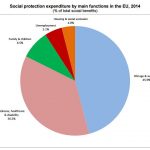This shows how unequal is the income among population in European countries
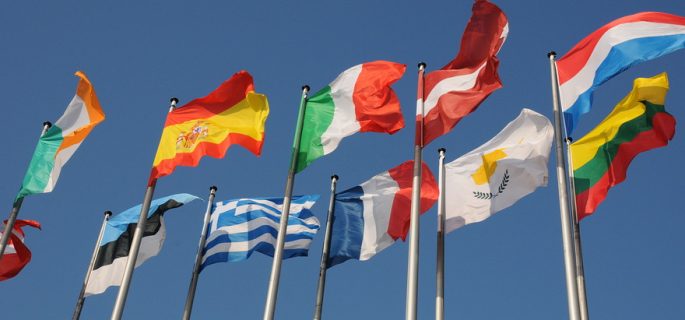
The top 20 % of the population in European countries, those with the highest equivalised disposable income, received 5.2 times as much income as the bottom 20 %.
Data extracted in February 2017. Most recent data: Further Eurostat information, Main tables and Database. Planned article update: February 2018.
This article analyses recent statistics on monetary poverty and income inequalities in the European Union (EU). Comparisons of standards of living between countries are frequently based on gross domestic product (GDP) per capita, which presents in monetary terms how rich one country is compared with another. However, this headline indicator says very little about the distribution of income within a country and also fails to provide information in relation to non-monetary factors that may play a significant role in determining the quality of life of a particular population. On the one hand, inequalities in income distribution may create incentives for people to improve their situation through work, innovation or acquiring new skills. On the other hand, such income inequalities are often viewed as being linked to crime, poverty and social exclusion.
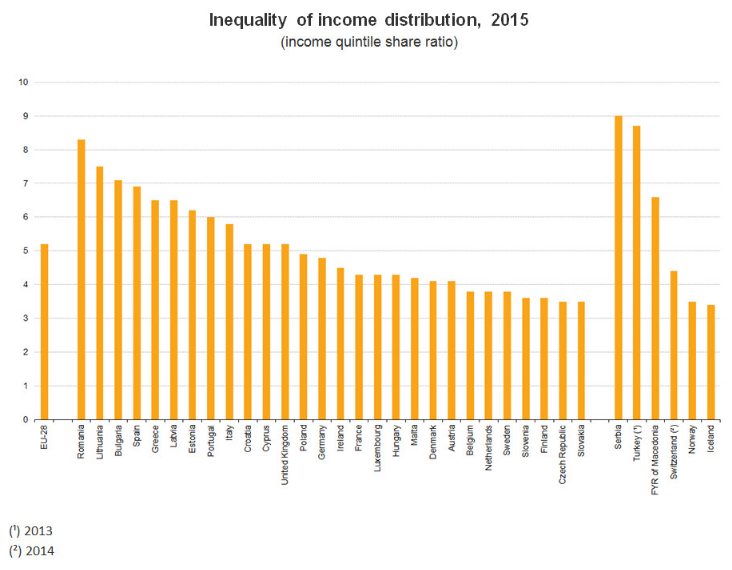
Main statistical findings
At-risk-of-poverty rate and threshold
The at-risk-of-poverty rate (after social transfers) in the EU-28 remained almost stable between 2010 and 2013, rising from 16.5 % to 16.7 %. Between 2013 and 2014, the at-risk-of-poverty rate increased by 0.5 percentage points and then increased slightly in 2015 (up 0.1 percentage points) to reach 17.3 %.
The rate for the EU-28, calculated as a weighted average of national results, conceals considerable variations across the EU Member States (see Figure 1). In eight Member States, namely Romania (25.4 %), Latvia (22.5 %), Lithuania (22.2 %), Spain (22.1 %), Bulgaria (22.0 %), Estonia (21.6 %), Greece (21.4 %) and Croatia (20.0 %), one fifth or more of the population was viewed as being at-risk-of-poverty; this was also the case in Serbia (25.4 %), Turkey (23.1 %, 2013 data) and the former Yugoslav Republic of Macedonia (21.5 %). Among the Member States, the lowest proportions of persons at-risk-of-poverty were observed in the Czech Republic (9.7 %) and the Netherlands (11.6 %), while Norway (11.9 %) and Iceland (9.6 %) also reported relatively low shares of their populations as being at-risk-of-poverty.
The at-risk-of-poverty threshold (also shown in Figure 1) is set at 60 % of national median equivalised disposable income. It is often expressed in purchasing power standards (PPS) in order to take account of the differences in the cost of living across countries. This threshold varied considerably among the EU Member States in 2015 from PPS 2.6 thousand in Romania to PPS 13.2 thousand in Austria, with the threshold in Luxembourg (PPS 17.6 thousand) above this range; the poverty threshold was also relatively low in the former Yugoslav Republic of Macedonia (PPS 2.7 thousand), Serbia (PPS 3.0 thousand) and Turkey (PPS 3.2 thousand, 2013 data) and relatively high in Switzerland (PPS 15.4 thousand, 2014 data) and Norway (PPS 17.0 thousand).
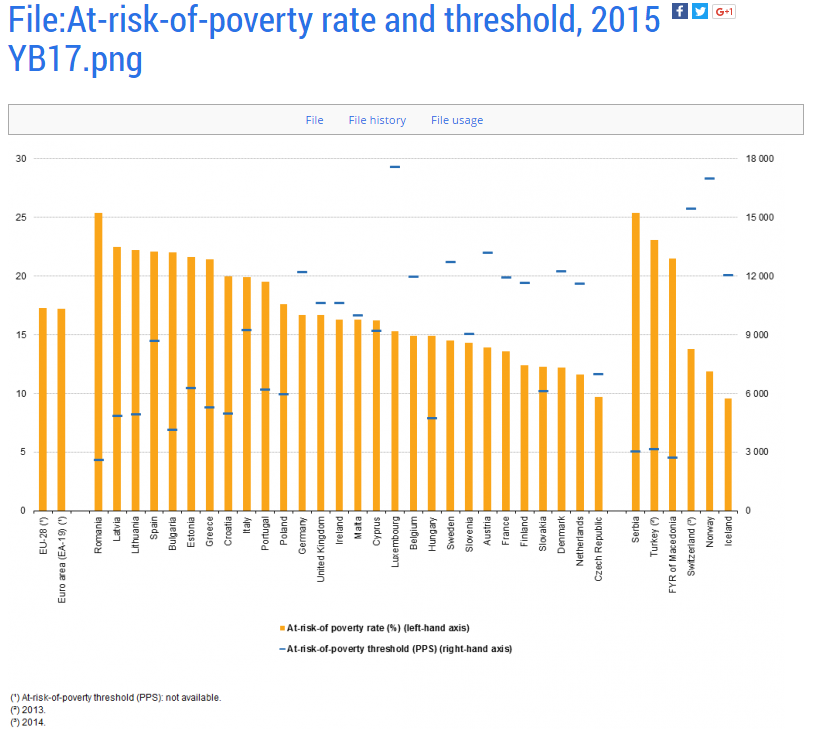
Figure 1
Different groups in society are more or less vulnerable to monetary poverty. In 2015, there was a relatively small difference in the at-risk-of-poverty rate (after social transfers) for the two sexes in the EU-28, with the latest rates equivalent to 16.9 % for males compared with a slightly higher figure (17.7 %) for females (see Figure 2). The largest gender difference in 2015 (5.1 percentage points) was observed in Latvia, while Bulgaria, Estonia, Sweden, Slovenia and the Czech Republic also reported at-risk-of-poverty rates for females that were 2.5 or more percentage points higher than for males, as was the case in Switzerland (2014 data) and Norway. By contrast, there were six EU Member States where the at-risk-of-poverty rate was slightly higher among men than women, namely Hungary, Poland, Spain, Denmark, the Netherlands and Greece, and this was also the case in Serbia.
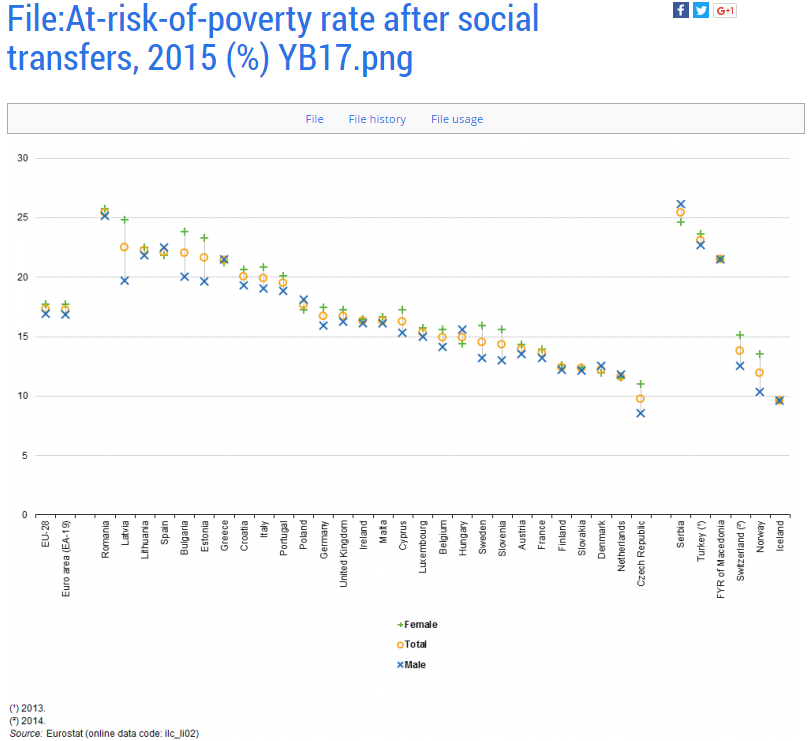
Figure 2
The differences in poverty rates were wider when the population was classified according to activity status (see Table 1). The unemployed are a particularly vulnerable group: almost half (47.5 %) of all unemployed persons in the EU-28 were at-risk-of-poverty in 2015, with by far the highest rate in Germany (69.1 %), while seven other EU Member States (the three Baltic States, Bulgaria, Hungary, Romania and Malta) reported that at least half of the unemployed were at-risk-of-poverty in 2015.
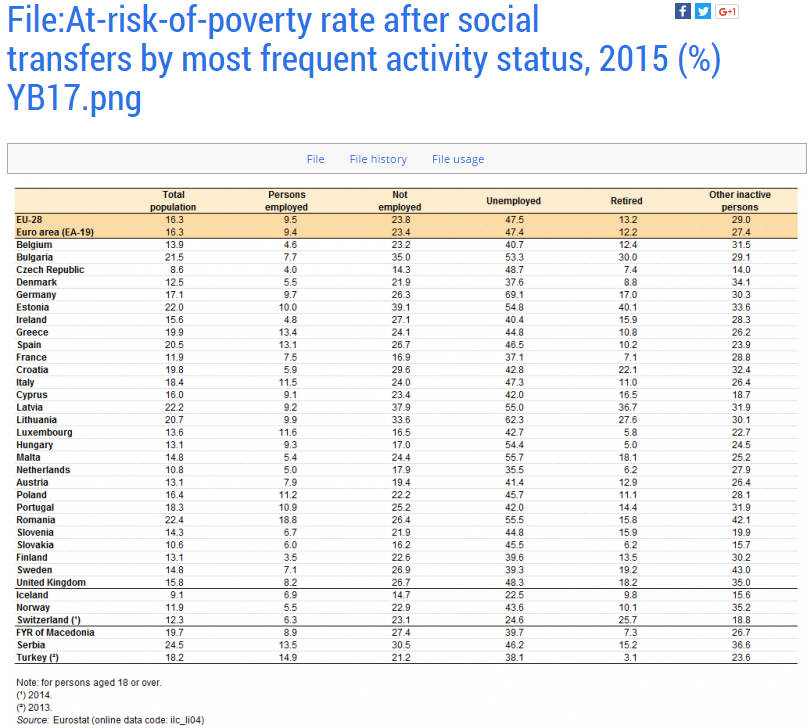
Table 1
Around one in eight (13.2 %) retired persons in the EU-28 were at-risk-of-poverty in 2015; rates that were at least twice as high as the EU-28 average were recorded in Lithuania (27.6 %), Bulgaria (30.0 %), Latvia (36.7 %) and Estonia (40.1 %).
Those in employment were far less likely to be at-risk-of-poverty (an average of 9.5 % across the whole of the EU-28 in 2015). There was a relatively high proportion of employed persons at-risk-of-poverty in Romania (18.8 %) and to a lesser extent in Greece (13.4 %) and Spain (13.1 %), while Luxembourg, Italy, Poland and Portugal each reported that in excess of 1 in 10 members of their respective workforces were at-risk-of-poverty in 2015.
At-risk-of-poverty rates are not uniformly distributed between households with different compositions of adults and dependent children. Among households without dependent children, people living alone were most likely to be at risk of poverty, a situation faced by 25.4 % of single person households in 2015. By contrast, the at-risk-of-poverty rate for households with two or more adults was less than half this rate, at 11.5 %. Looking specifically at two adult households where at least one person was aged 65 or over, the at-risk-of-poverty rate was slightly lower, at 10.4 %.
The majority of EU Member States reported a similar pattern: single person households had the highest at-risk-of-poverty rates among households without dependent children in all Member States except in Malta, where two adult households where at least one person was aged 65 or over had a higher rate; a similar situation to that observed in Malta was repeated in the former Yugoslav Republic of Macedonia except that single person households reported the lowest rate among the three types analysed. The at-risk-of-poverty rate for two adult households where at least one person was aged 65 or over was generally lower than the rate for the broader category of all households with two or more adults, although this was not the case in Cyprus, Estonia, Austria, the United Kingdom, Belgium, Latvia, Croatia, Bulgaria and Malta.
Turning to households with dependent children, the highest at-risk-of-poverty rate in the EU-28 was recorded for single persons with dependent children, at close to one third (33.7 %). Comparing the rates for households with two adults, those with just one dependent child (12.9 %) had a risk of poverty that was just less than half that recorded for households with three or more dependent children (27.1 %). Among the three household types shown in Figure 4, all EU Member States reported that households composed of two adults and a single child were the least likely to be at risk of poverty; note that in Iceland the lowest risk of poverty was recorded among households composed of two adults with three or more dependent children. Most EU Member States also reported that the at-risk-of-poverty rate was highest for single persons with dependent children, although there were a number of exceptions where the rate was higher for households composed of two adults with three or more children, most notably Bulgaria and Romania, and to a lesser extent Spain, Portugal, Slovakia, Italy, Poland and Croatia; this situation also occurred in the former Yugoslav Republic of Macedonia and Turkey (2013 data), and to a lesser extent Switzerland (2014 data) and Serbia.
Social protection measures can be used as a means for reducing poverty and social exclusion. This may be achieved, for example, through the distribution of benefits. One way of evaluating the success of social protection measures is to compare at-risk-of-poverty indicators before and after social transfers. In 2015, social transfers reduced the at-risk-of-poverty rate among the population of the EU-28 from 26.0 % before transfers to 17.3 % after transfers, thereby lifting 8.7 % of the population above the poverty threshold; without social transfers these people would be at-risk-of-poverty. Comparing at-risk-of-poverty rates before and after social transfers, the relative impact of social benefits was low in Romania, Greece, Latvia, Poland and Italy, as well as in Turkey (2013 data) and the former Yugoslav Republic of Macedonia. By contrast, half or more of all persons who were at-risk-of poverty in Ireland, Finland and Denmark moved above the threshold as a result of social transfers, as was also the case in Norway and Iceland.
Income inequalities
Governments, policymakers and society in general cannot combat poverty and social exclusion without analysing the inequalities within society, whether they are economic or social in nature. Data on economic inequality become particularly important for estimating relative poverty, because the distribution of economic resources may have a direct bearing on the extent and depth of poverty.
There were wide inequalities in the distribution of income in 2015: a population-weighted average of national figures for each of the individual EU Member States shows that the top 20 % of the population (with the highest equivalised disposable income) received 5.2 times as much income as the bottom 20 % (with the lowest equivalised disposable income). This ratio varied considerably across the Member States, from 3.5 in Slovakia and the Czech Republic, to 6.0 or more in Portugal, Estonia, Latvia, Greece, Spain, Bulgaria and Lithuania, peaking at 8.3 in Romania. Among the non-member countries shown in Figure 6, Iceland (3.4) and Norway (3.5) also reported particularly low ratios for the inequality of income distribution, while in Turkey (8.7, 2013 data) and Serbia (9.0) the ratios were higher than in any of the EU Member States.
There is policy interest in the inequalities felt by many different groups in society. One group of particular interest is that of the elderly, in part reflecting the growing proportion of the EU’s population that is aged 65 and over. Pension systems can play an important role in addressing poverty among the elderly. In this respect, it is interesting to compare the incomes of the elderly with the rest of the population.
Across the EU-28 as a whole, people aged 65 and above had a median income which in 2015 was equal to 93 % of the median income for the population under the age of 65. In six EU Member States (Luxembourg, Greece, France, Spain, Hungary and Romania) the median income of the elderly was equal to or higher than the median income of persons under 65, and this was also the case in the former Yugoslav Republic of Macedonia, Serbia and Turkey (2013 data). In Italy, Poland, Austria, Portugal, Slovakia and Slovenia the median income of the elderly was at least 90 % of that recorded for people under 65, and this was also the case in Norway. Ratios below 80 % were recorded in Belgium, Sweden, Denmark, Malta, Lithuania, Bulgaria, Latvia and Estonia; these relatively low ratios may broadly reflect pension entitlements.
The depth of poverty, which helps to quantify just how poor the poor are, can be measured by the relative median at-risk-of-poverty gap. The median income of persons at risk of poverty in the EU-28 was, on average, 24.8 % below the poverty threshold in 2015; this threshold is set at 60 % of the national median equivalised disposable income of all persons. Among the EU Member States, the relative median at-risk-of-poverty gap was widest in Romania (38.2 %) and Spain (33.8 %), with a gap above 25.0 % also reported for Greece, Bulgaria, Italy, Portugal, Slovakia, Croatia, Lithuania and Latvia. The gap was also relatively high in Serbia (37.6 %) and the former Yugoslav Republic of Macedonia (33.1 %) and was above 25.0 % in Turkey (2013 data). The lowest at-risk-of-poverty gap among the Member States was observed in Finland (13.2 %), followed by France (15.7 %).
Data sources and availability
EU statistics on income and living conditions (EU-SILC) were launched in 2003 on the basis of a gentlemen’s agreement between Eurostat, six EU Member States (Austria, Belgium, Denmark, Greece, Ireland, Luxembourg) and Norway.
Read more on this statistical report HERE
Source: eurostat









